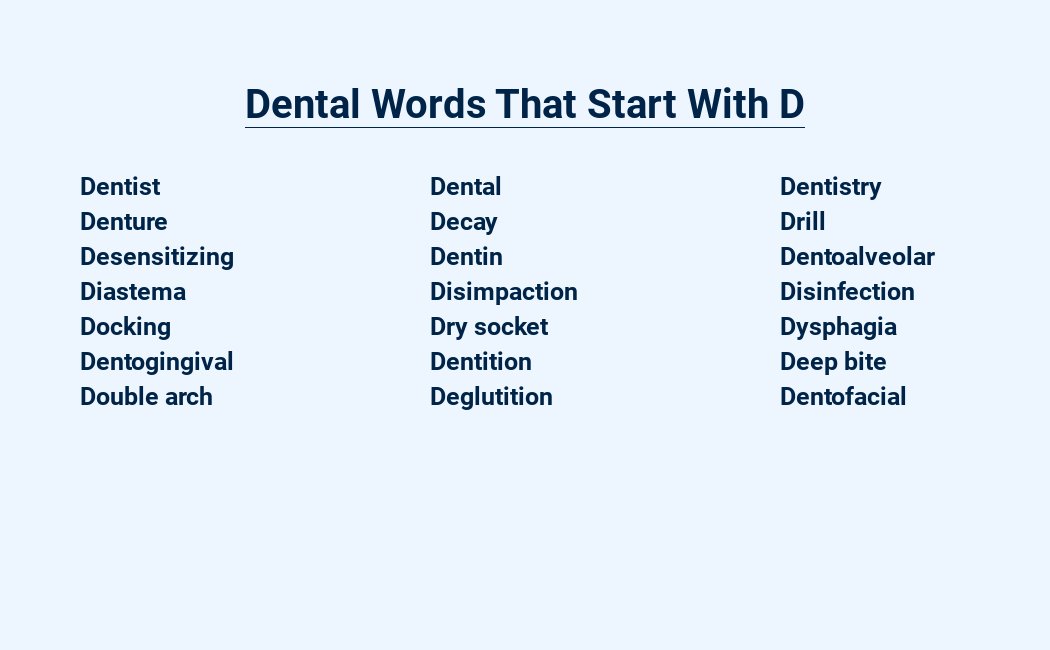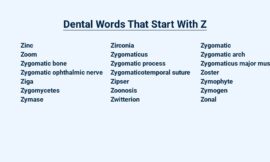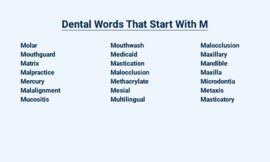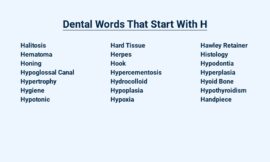Hello, I’m here to introduce you to some important dental words that begin with the letter “D.” Stay tuned to learn more about terms like dental calculus, caries, cement, crowns, dams, decay, drills, floss, fluoride, and the significance of dental hygiene.
| Dental Term | Meaning |
| Dentin | The hard, inner layer of a tooth beneath the enamel and outer to the pulp chamber. |
| Dental floss | A thin string to clean between teeth and remove plaque and food particles. |
| Dentifrice | A toothpaste or powder used to clean teeth. |
| Dental implant | A surgical component that interfaces with the bone of the jaw or skull to support a dental prosthesis. |
| Dental scaler | A dental instrument used to remove calculus (tartar) and plaque from the teeth. |
| Dentist | A person qualified to practice dentistry, the branch of medicine concerned with the teeth, gums, and mouth. |
| Dental sealant | A thin, plastic coating applied to the chewing surfaces of teeth to prevent decay. |
| Dentoalveolar | Relating to the teeth and the bony sockets in which they are embedded. |
- Dental Amalgam: A material used to fill cavities in teeth, made from a mixture of mercury, silver, tin, and copper.
- Dental Anesthesia: The use of medications to numb pain during dental procedures.
- Dental Arch: The horseshoe-shaped arrangement of teeth in the upper and lower jaws.
- Dental Articulator: A device used to simulate the movement of the jaw and teeth, helping dentists to create properly fitting dental restorations.
- Dental Assistant: A healthcare professional who helps dentists with patient care, including preparing patients for procedures, taking X-rays, and sterilizing instruments.
- Dental Bridge: A fixed dental restoration that replaces one or more missing teeth by attaching artificial teeth to adjacent teeth.
- Dental Calculus: Hard, calcified deposits that form on teeth, commonly known as tartar.
- Dental Caries: The destruction of tooth tissue caused by bacteria, commonly known as tooth decay.
- Dental Cement: A material used to bond dental restorations to teeth, such as crowns, bridges, and fillings.
- Dental Clinic: A facility where dentists and other dental professionals provide oral healthcare services to patients.
- Dental Composite: A tooth-colored material used to restore decayed or damaged teeth.
- Dental Crown: A cap that is placed over a tooth to restore its shape, strength, or appearance.
- Dental Dam: A sheet of rubber or latex that is placed over the teeth during certain dental procedures to isolate the treatment area and prevent the patient from swallowing or inhaling foreign objects.
- Dental Decay: The destruction of tooth tissue caused by bacteria, commonly known as tooth decay.
- Dental Drill: A high-speed rotating tool used to remove decayed tooth tissue and prepare teeth for fillings or other restorations.
- Dental Floss: A thin, string-like material used to clean between teeth and remove plaque and food particles.
- Dental Fluoride: A mineral that helps to strengthen teeth and prevent tooth decay.
- Dental Hygiene: The practice of maintaining good oral health by brushing, flossing, and visiting the dentist regularly.
- Dental Implant: A surgical procedure in which a metal post is placed in the jawbone to support a dental crown or bridge.
- Dental Impression: A mold of the teeth and surrounding tissues, used to create dental restorations such as crowns, bridges, and dentures.
- Dental Laboratory: A facility where dental technicians create and repair dental restorations, such as crowns, bridges, and dentures.
- Dental Malocclusion: An improper alignment of the teeth, also known as a bad bite.
- Dental Matrix: A device used to shape and contour dental fillings.
- Dental Patient: A person who seeks dental care from a dentist.
- Dental Plaque: A sticky film of bacteria that forms on teeth and can cause tooth decay and gum disease.
- Dental Polishing: The process of smoothing and shining the surface of teeth after a dental procedure.
- Dental Pulp: The soft tissue inside the tooth that contains nerves, blood vessels, and connective tissue.
- Dental Radiograph: An X-ray image of the teeth and surrounding structures, used for diagnostic purposes.
- Dental Sealant: A thin, protective coating applied to the chewing surfaces of teeth to prevent tooth decay.
- Dental Sta
Dental Words That Start with D
Dental Calculus
Dental calculus, commonly known as tartar, is a hard, mineralized deposit that forms on teeth due to accumulated plaque. Tartar can cause gum irritation, bleeding, and eventually lead to gum disease and tooth decay.
Regular dental cleanings can help remove calculus and maintain good oral hygiene.
Dental Caries
Dental caries, commonly known as tooth decay, is a prevalent oral disease caused by the interaction of bacteria, fermentable carbohydrates, and host factors. It leads to the breakdown of tooth structure, resulting in cavities and potential pain, sensitivity, and infection.
Prevention and early treatment are crucial to maintain good oral health.
Dental Cement
Dental cement is a material used in dentistry to bond various dental restorations to teeth.
It is typically made from a combination of acrylic resin, glass ionomer, or other materials.
Dental cement is used to secure crowns, bridges, inlays, onlays, and veneers.
It also helps to prevent decay and leakage around the margins of the restoration.
Dental Crown
A dental crown is a tooth-shaped cap that fits over a damaged or decayed tooth to restore its strength, shape, and appearance. Crowns are usually made of porcelain, metal, or a combination of both materials.
They can be used to protect a weak tooth, restore a broken tooth, or improve the appearance of a discolored or misshapen tooth.
Dental Dam
Dental dam, a thin sheet of latex or other material placed over the treatment area in the mouth, isolates the teeth and gums from saliva and other contaminants, helping to prevent infection and cross-contamination.
Dental Decay
Dental decay, also known as cavities, is the destruction of tooth tissue caused by acids produced by bacteria. It can lead to pain, infection, and tooth loss if left untreated.
Regular brushing, flossing, and dental checkups are essential for preventing and treating dental decay.
Dental Drill
Dental drill, also known as a dental handpiece, is a high-speed rotary tool used in dentistry to remove tooth decay, shape teeth, and perform other dental procedures. It is a commonly used tool in dental practices and plays a crucial role in maintaining oral health.
Dental Floss
Dental floss is a thin, string-like material used to clean between teeth. It helps remove plaque, food particles, and bacteria that regular brushing cannot reach.
Daily flossing helps prevent cavities, gum disease, and bad breath, contributing to overall oral health.
Dental Fluoride
Dental Fluoride: A Vital Mineral for Healthy Teeth Fluoride plays a crucial role in maintaining oral health.
Found naturally in water and some foods, fluoride helps strengthen tooth enamel, prevent cavities, and reduce the risk of tooth decay.
Regular use of fluoride toothpaste, mouthwash, and professional fluoride treatments can help protect and preserve your teeth.
Dental Hygiene
Dental hygiene is the practice of keeping your teeth and gums clean and healthy. It involves brushing, flossing, and regular dental checkups.
Good dental hygiene can prevent cavities, gum disease, and other oral health problems.
Final Verdict
The realm of dentistry encompasses an array of terms beginning with the letter “D.” These include dental calculus, caries, cement, crown, dam, decay, drill, floss, fluoride, and hygiene. Each term holds significance in maintaining oral health, from preventing plaque buildup and cavities to restoring damaged teeth and ensuring proper oral hygiene practices.
Understanding these dental terms empowers individuals to make informed decisions regarding their oral health and seek appropriate dental care when necessary.




